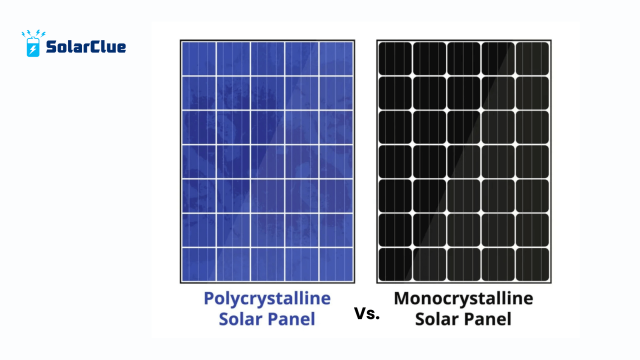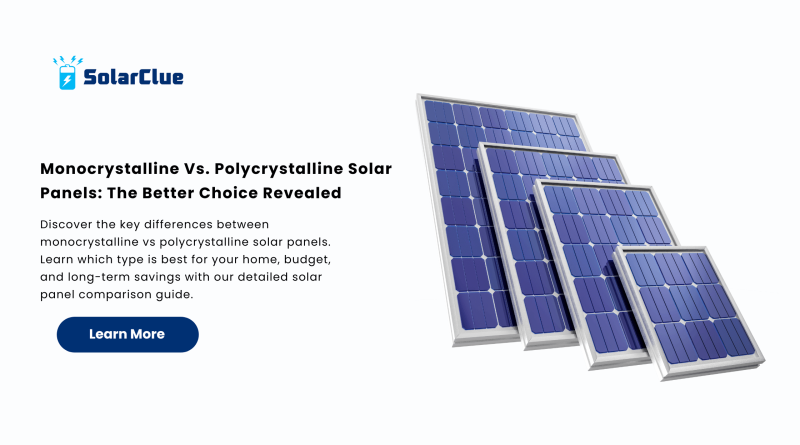Monocrystalline Vs. Polycrystalline Solar Panels: The Better Choice Revealed
As more households and businesses turn to solar energy solutions, understanding the different types of solar panels becomes essential. Among the most popular are monocrystalline solar panels and polycrystalline solar panels. These two dominate the market due to their reliability and efficiency, but choosing between them can be tricky.
Table of Contents
- 1 What Are Monocrystalline Solar Panels?
- 2 What Are Polycrystalline Solar Panels?
- 3 Efficiency Face-Off: Monocrystalline Vs Polycrystalline
- 4 Cost Comparison: Breaking Down Solar Panel Costs
- 5 Performance and Longevity
- 6 Best Use Cases: Which Solar Panels Are Best for You?
- 7 Environmental Impact and Renewable Energy Options
- 8 Solar Panel Buying Guide: What to Consider
- 9 Durability and Weather Resistance
- 10 Installation Process and Guidance
- 11 Real-World Solar Panel Comparison
- 12 Savings Over Time: Use a Solar Savings Calculator
- 13 Summary: The Verdict on Monocrystalline Vs. Polycrystalline
- 14 FAQs
What Are Monocrystalline Solar Panels?
Monocrystalline solar panels are made from a single, pure silicon crystal. This type of panel is known for its sleek black appearance and high efficiency. It’s often considered the most efficient solar panel type due to its ability to convert more sunlight into electricity.
Advantages of Monocrystalline Solar Panels
- Higher efficiency rates (15-22%)
- Better performance in low-light and high-heat conditions
- Longer lifespan and higher solar panel durability
- Require less space for installation
Disadvantages of Monocrystalline Panels
- Higher upfront costs
- Manufacturing process is more complex, leading to higher production waste
What Are Polycrystalline Solar Panels?
Polycrystalline solar panels are created by melting multiple silicon fragments together. These panels typically appear blue and have a speckled look due to the silicon grains.
Benefits of Polycrystalline Panels
- Lower solar panel cost comparison to monocrystalline
- Easier and less expensive to produce
- Environmentally friendlier production
Disadvantages of Polycrystalline Solar Panels
- Lower efficiency (13-16%)
- Require more roof space for equivalent power
- Less effective in high-heat or shaded areas
Efficiency Face-Off: Monocrystalline Vs Polycrystalline

When it comes to monocrystalline vs polycrystalline efficiency, monocrystalline panels generally come out on top. If your goal is maximizing power output in a small space, monocrystalline solar panels are the better option. However, polycrystalline efficiency is sufficient for areas with abundant sunlight and space.
Cost Comparison: Breaking Down Solar Panel Costs
The cost of solar panel installation is a crucial factor. Polycrystalline panels tend to be 10–20% cheaper than monocrystalline. However, due to their lower efficiency, you may need more panels, which could balance out the initial savings.
Performance and Longevity
When evaluating solar panel performance and solar panel longevity, monocrystalline panels often have a lifespan of 25–30 years, while polycrystalline ones last around 20–25 years. The performance degradation rate is also slower in monocrystalline models.
Best Use Cases: Which Solar Panels Are Best for You?
Monocrystalline is best if:
- You have limited roof space
- You want high efficiency
- You’re investing for long-term gains
Polycrystalline is best if:
- You have plenty of roof space
- You’re budget-conscious
- Your area gets consistent, direct sunlight
Environmental Impact and Renewable Energy Options
Choosing between the two also involves considering environmental impact. While both are viable renewable energy options, polycrystalline panels are slightly greener in terms of manufacturing. However, monocrystalline panels’ longevity often offsets their production footprint.
Solar Panel Buying Guide: What to Consider
- Budget vs. long-term savings
- Available installation space
- Sunlight exposure
- Aesthetic preferences
- Efficiency and performance needs
For a detailed breakdown, refer to our solar panel buying guide.
Durability and Weather Resistance
In terms of solar panel durability, both types are built to withstand tough conditions. Monocrystalline panels, however, tend to perform better in extreme heat and over longer durations.
Installation Process and Guidance
Our solar installation guide covers everything from evaluating your roof to post-installation maintenance. Whether you choose monocrystalline or polycrystalline, professional installation is key to maximizing benefits.
Real-World Solar Panel Comparison
In real-world tests, monocrystalline panels often outperform their polycrystalline counterparts in both urban and rural settings. Their adaptability to different light conditions makes them suitable for a broader range of homes.
Savings Over Time: Use a Solar Savings Calculator
Use a solar savings calculator to estimate your return on investment. While monocrystalline systems cost more initially, they often yield higher long-term savings through superior solar panel performance.
Summary: The Verdict on Monocrystalline Vs. Polycrystalline
While both have merits, monocrystalline solar panels are the best solar panels for those seeking maximum efficiency and long-term value. However, polycrystalline solar panels remain a strong option for budget-conscious buyers with ample space.
FAQs
1. Which solar panel type lasts longer?
Monocrystalline panels typically last 25–30 years, while polycrystalline panels last 20–25 years.
2. Are monocrystalline panels worth the extra cost?
Yes, for higher efficiency and longer lifespan, they often pay off in the long run.
3. Do both types work well in all climates?
Monocrystalline panels perform better in varied weather, especially heat and shade.
4. Is it possible to mix both panel types in one system?
Technically yes, but it’s not recommended due to differing efficiencies.
5. What are the latest trends in solar panel technology?
Hybrid panels, bifacial cells, and improved energy storage are current innovations.
Still wondering which panel is right for you? Explore all your options and get expert guidance at solarclue.com and check out more insights on blog.solarclue.com. Let the sunshine power your home the smart way!


